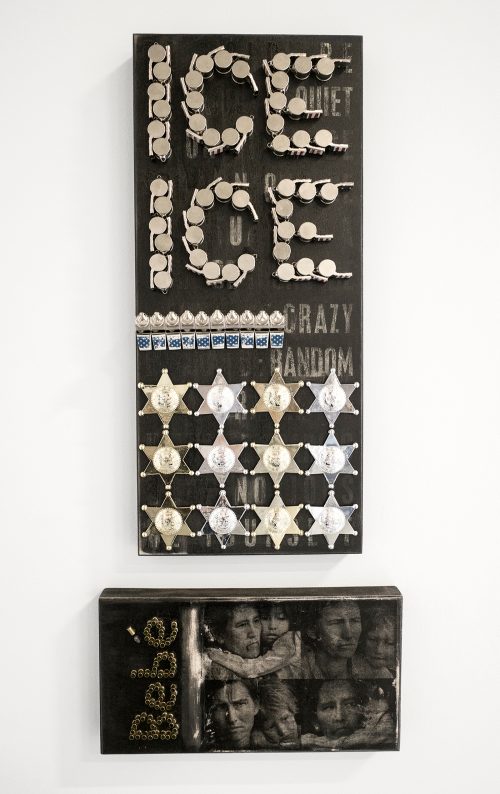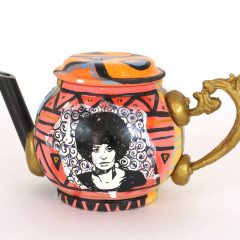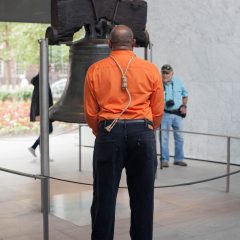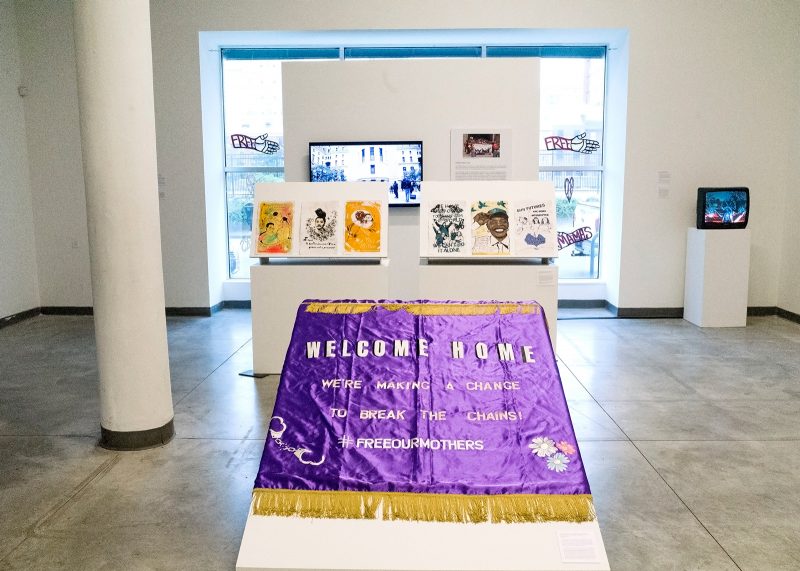
It is, unfortunately, a prescient time to show a group of works that examines the history and practices of incarceration in the United States. Americans have short memories when we feel like it; the dominant cultural narrative of American innocence and exceptionalism absolutely crumbles in the face of reality, as explored in ABOLITION NOW!, a group exhibition currently on view at the Asian Arts Initiative. Comprising a wide variety of media, including video, installation, painting, and photography, ABOLITION NOW! combines art and activism in concrete and visceral ways. The focus is not only on the exhibited pieces by artists, but on the arts-related work of local prison abolition and anti-incarceration groups, like the Youth Art & Self-Empowerment Project and the People’s Paper Co-op. The overall effect is staggering, reminding us that there is much important work underway and yet to be accomplished in combating this form of oppression.
While the exhibition features instances of Asian American incarceration in the United States, the overall goal is to present a larger pattern of incarceration that implicates white supremacy in the United States, and how that philosophy manifests in the oppression of people of color. Milestones and hallmarks of American incarceration are presented in red text on the white walls, creating themed sections of the exhibition that tackle: the institution of African-American slavery; the 1940s Japanese-American internments; the prison management system and its transition from government ownership to private prisons run by multi-national corporations (dubbed the prison industrial complex); to the current concentration camp conditions for Central American refugees and immigrants dotting the Mexican border. ABOLITION NOW!’s strength as an artistic and political statement lies in how the artists and activists themselves make connections between these historical modes of incarceration and contemporary practices.
“Oil, Bananas, Prisons,” a collaborative work by Sara Zia Ebrahimi and Gralin Hughes, combines video projection with textiles to tell the story of how American imperialism has affected not just the Muslims who are banned from coming here now or the Central American refugees being held at our border, but how those two groups are linked irrevocably by American imperialism. Specifically, the label text mentions the 1953 coup of Iran’s elected leader Mohammad Mossadegh, and the 1954 coup in Guatemala to benefit the United Fruit Company’s “banana republic,”, Both coups were the work of the CIA to protect what it saw as American interests in oil (Iran) and bananas (Central America). The prisons of the work’s title make up the third leg of this relationship, as private prisons crop up across America, to hold and control the flow of refugees fleeing from countries like Guatemala that remain unstable largely as a result of American interference. As presented by Ebrahimi and Hughes, the cycle is unceasing, refusing to let us treat these incidences as isolated.
The gray-scale portrait of Michael Donald (a victim of lynching in 1981), titled “Mockery” and painted onto a fashionable tan jumpsuit, that references Burberry’s infamous hoodie with a noose makes an immediate, direct impression as it condemns tendencies of appropriating and decontextualizing props and hallmarks of oppression. Russell Craig, a returning citizen and self-taught artist and their mixed media “Mockery” links together lynching, the prison complex and high end fashion as institutions that endanger Black bodies.**
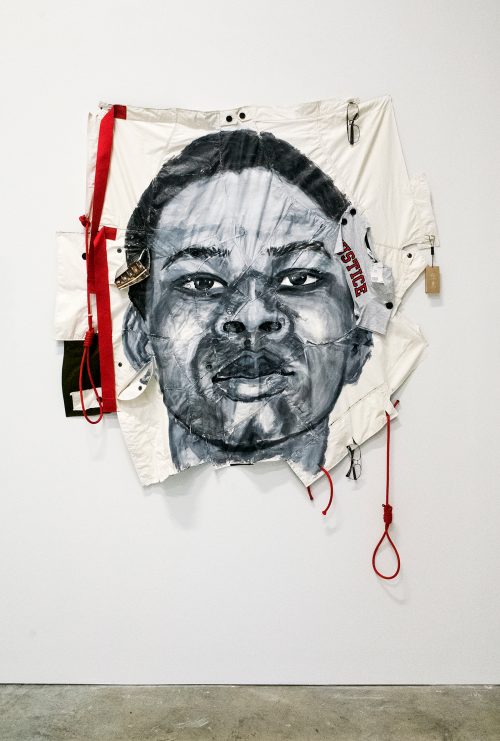
Japanese internment and African-American slavery are linked through photography and poetry in Kamal Badhey and Karla Robinson’s “Land Witness” series. The photographs were taken by Badhey at the site of the Rohwer Relocation Center, a former Japanese concentration camp in Arkansas; each image is paired with a short poem by Robinson. Together, the artists ruminate on the legacy of incarceration of Japanese Americans as well as the camp’s location in the Jim Crow South, and the images and words complement one another in startling and harmonic ways. A photograph of a mushroom growing from a hole in a tree trunk is paired with a short poem containing the lines:
“As a blk womyn, / It’s not like I didn’t know / America kills / United States death / Taxes paid with blood and breath / Auction block goodbyes / And then I learned more / Dug deep into hidden truths.”
It’s as if Badhey’s photograph of that spongy mushroom peeking out of the tree trunk and emerging from it is in sync with Robinson’s choice to learn, to grasp for new knowledge and understanding.
In another diptych in “Land Witness,” a photograph depicting a tall, thin monument capped with an eagle is shot from a low angle, partially blocking out the sun. The accompanying lines of poetry begin “They do what they want / ‘Papers’ don’t mean anything” and end with “Marked, then rounded up / One hundred, twenty thousand / Citizens of this / Great and noble land / Kept captive without a sound / Government decree.” The eagle, the emblem of the United States, sits at the top of the monument, towering above the viewer, which visually emphasizes the actions of the United States government described in the poem as something fearsome and cruel. The words and the images reinforce one another, and the message.
The second half of ABOLITION NOW! transitions from the global and historical to the local and contemporary. One set of paintings is a project of the Youth Art & Self-Empowerment Project, which works to stop the practice of trying young people as adults in the commonwealth of Pennsylvania. The works, created in concert with incarcerated youth, feature images of globes and hands with broken chains, envisioning a world without prisons. Just around the corner, the fashion hoodie-noose cited by Craig is a reminder that the hallmarks of punishment and incarceration are viewed as aesthetics instead of as tools of oppression to be obliterated. Also on display are striking posters created by the People’s Paper Co-op, a local project that advocates for incarcerated people. These posters, produced in collaboration with artists such as Molly Crabapple, raised money for the Philadelphia Community Bail Fund, helping incarcerated women who didn’t have the money for cash bail. The underlying message of these two projects is about the urgency of collaboration, of solidarity, of skill-sharing, and of mutual aid in the struggle for justice.
ABOLITION NOW! does more than present the contours and details of the problem of mass incarceration: it contextualizes incarceration across American history, showing that the fight against white supremacy in the United States is truly long-standing and complex, and has affected numerous populations across lines of race and national origin. The art in ABOLITION NOW! is therefore successful because it weds strong and compelling visual storytelling to a strong and compelling message.
Abolition Now! At Asian Arts Initiative, 1219 Vine St., until Aug. 30, 2019. Closing Reception – August 23, 6 – 11 p.m. Group exhibition with Kamal Badhey and Karla Robinson | MyLoan Dinh | Sara Zia Ebrahimi and Gralin Hughes | Lacey Johnson | Justine Lai | William Wallace/ Russell Craig | Juntos | People’s Paper Co-op | Youth Art & Self-Empowerment Project
**Similarly, the upcoming HBO television show Confederate, telling an alternate history of the American South in which the Confederacy won, and slavery is still legal in the 21st century, is another instance where the motifs and symbols of oppression, become nothing more than frivolous art or entertainment
